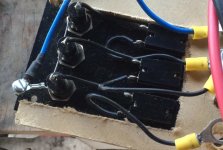NeilP
1 GW
I have just acquired a solar setup, from a chap I helped a few years ago.
200W of panels
a PR1010 charge controller . Charge controller is designed to have panel, load and battery connected to monitor battery SoC
160Ah Lead acid deep cycle 12v battery
Inveter: Pure Sine wave 240 volt 600W continuous, 1200 W peak/surge
He always complained that the inverter would not run his BMS Alloy shell switched mode PSU charger.
Specs are,
600W lipo charger. set to 83 volts and 5 maps. Stand alone CA shows 400Watt going in to the battery.
Well, to be accurate it shows the 400 watt and the 5 amp charge when connected to the 240 house mains.
But if run on the inverter, it only puts out 0.5- 0.7 amps, 40-50 watts.
When I saw his initial wiring via a switch board and a fuse and the solar charge controller, I thought I had found the problem. The PR1010 solar charge controller is only good for 10 amps output...umm I thought..10 amps at 12 volt is not going to power a 600/ 1200 watt device.
So I now have the inverter connected direct with 8 gauge cable direct to the battery.
But still the inverter wont run the LiPo charger...well it runs it, but not at greater than 0.7 amps.
I have checked the inverter input current and it is drawing 4 or 5 amps with good battery voltage (13.4 volts ) at the inverter input. There is no voltage drop in the feed line from battery to inverter. Voltage at either end is within 0.01 volt.
Any idea what can be going on here? some incompatibility between a Pure Sinewave output and the Switched Mode PSU ?
200W of panels
a PR1010 charge controller . Charge controller is designed to have panel, load and battery connected to monitor battery SoC
160Ah Lead acid deep cycle 12v battery
Inveter: Pure Sine wave 240 volt 600W continuous, 1200 W peak/surge
He always complained that the inverter would not run his BMS Alloy shell switched mode PSU charger.
Specs are,
600W lipo charger. set to 83 volts and 5 maps. Stand alone CA shows 400Watt going in to the battery.
Well, to be accurate it shows the 400 watt and the 5 amp charge when connected to the 240 house mains.
But if run on the inverter, it only puts out 0.5- 0.7 amps, 40-50 watts.
When I saw his initial wiring via a switch board and a fuse and the solar charge controller, I thought I had found the problem. The PR1010 solar charge controller is only good for 10 amps output...umm I thought..10 amps at 12 volt is not going to power a 600/ 1200 watt device.
So I now have the inverter connected direct with 8 gauge cable direct to the battery.
But still the inverter wont run the LiPo charger...well it runs it, but not at greater than 0.7 amps.
I have checked the inverter input current and it is drawing 4 or 5 amps with good battery voltage (13.4 volts ) at the inverter input. There is no voltage drop in the feed line from battery to inverter. Voltage at either end is within 0.01 volt.
Any idea what can be going on here? some incompatibility between a Pure Sinewave output and the Switched Mode PSU ?


